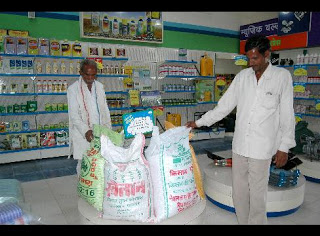 When we last examined the Indian IT boom on this blog we were left with a few important conclusions. First, it became clear that the IT boom was driven by software exports and that these exports grew linearly until 1992. In that year something happened in the industry and software exports began to take off in an exponential manner.
When we last examined the Indian IT boom on this blog we were left with a few important conclusions. First, it became clear that the IT boom was driven by software exports and that these exports grew linearly until 1992. In that year something happened in the industry and software exports began to take off in an exponential manner.
Knowing that the primary input into software is labor, and that the rate of employment growth didn’t change dramatically, we can be certain that this take off in software exports was caused by massive increases in labor productivity; and we have a graph to show it. The figure below shows revenues per worker in the software industry over the course of the 1990s.
The takeoff is extraordinary. By the late 1990s software firms were hiring as many engineers as they could find, and each additional worker was leading to even higher marginal revenues. Shockingly, despite the huge IT workforce that was a precursor to the boom in the first place, by the end of the decade the number one complaint of IT firms in business surveys was a scarcity of labor.
The boom in labor productivity could only have come from two sources: better management practices and moving up the value chain (and it in fact came from both). India already had highly trained workers, and these workers were already working with advanced machinery. They were however engaged in simple work conducted “on-site” – mostly systems design, analysis and coding. There were few, if any, Indian firms doing turnkey software projects. By the early 2000s that fact had changed completely. Whereas in 1988 90% of all software exports were “on-site” services, by 2003 that number was down to 40% and falling.
What happened to allow India to move up the software value chain and to force firms to invest heavily in improved management practices? The logical place to start looking for clues is in the massive political change that occurred in India in 1991. In the 1950’s Nehru had established a Soviet-style system of central planning and restrictions on the private sector that came to be known as the “License Raj.” But in ’91, facing a currency crisis that required IMF intervention, the international community forced reforms on India that made it much easier for businesses to spring up and foreign investment to pour in. And pour in it did: the graph below shows foreign investment into India throughout the 1990s. Its exponential shape seems to mirror that of software exports.
But of course the story isn’t quite that simple. While the 1992-99 period did see 68 multinational software firms establish offices in the country, software exports have always been largely the domain of domestic firms. By 2001 multinationals still accounted for only 15% of such exports from India.
It is also important to note that in 1990 and 1991 the government established a series of software technology parks (STPs). The first one opened in Bangalore in August 1990 and included modern communications networks that were beyond the reach of ordinary firms. Even after liberalization the government continued to do this, and by 2002 there were 39 parks that together accounted for 80% of the country’s software exports.
So we have a lot of different elements – some involving liberalization and some involving outright subsidization – that were woven together to create a unique growth recipe for IT in India. The story can be told briefly somewhat like this.
In the mid-1980s, while Indian IT was almost entirely focused on on-site services, Texas Instruments came in and established a research and development center in Bangalore. The exact reasons they were willing to go through the trouble of starting a subsidiary in India during the License Raj years are unknown, but the fact that they had an IIT-educated Indian VP may well have had something to do with it. Many of their multinational competitors watched from afar as this business was set up, but none followed. Bangalore at the time TI arrived was a hub of the Indian defense industry, home of an IIT, and a logical place for the government to establish a science and technology park. They did so largely at the urging of the software exporters specializing in “on-site” software development. They felt that with better data links to their work sites (links they couldn’t afford on their own) they would be better able to do more of their work in India. That would save them a large amount of money in both travel and in the division of labor. Often consultants that went out from India on site visits were top tier company employees – they had to be capable of the most complex tasks that clients would ask of them. But these top employees spent little of their time on the ground doing complex tasks. Often times they simply coded, a job for which software engineers in the US and Europe almost never do Pronab Sen noted that because of this phenomenon the average productivity of an Indian on-site software engineer in the US was only 30% of his American counterpart. With reliable data links the on-site consultant could farm this work out to employees at home and spend more of his time doing complex work.
By 1993 this had begun to happen. “Off-shoring,” the development of software in India, had jumped by a third over the previous two years. Consequently, the labor productivity associated with the primary industry laborers, the on-site software engineers, had begun to soar. As more and more work was done off-shore by the companies that had previously requested on-site services, they became more comfortable with it. Gradually, more and more valuable work was allowed to be off-shored.
At the same time that “on-site” consulting firms were beginning to do more offshore work India was liberalizing. The firms that had long watched Texas Instruments, and had seen them prove that successful R&D could be done in India, finally could make a business case to move into the country.
So foreign software firms began to move into India, and previously on-site clients began to do more work off-shore, all at the same time. This led to a fierce competition for the primary resource in the IT sector, programmers and engineers. But interestingly, as pointed out by the economist Suma Athreye, the Indian firms and the multinationals were only competing in the input market, not the product market. The large multinational subsidiaries established in India sold their product only to their parent company. This meant that the presence of multinational firms in India forced salaries up, forced domestic firms to adopt more efficient labor use strategies, but did not compete with (and potentially destroy) them. These positive incentives had an impact on labor productivity. By the late 1990’s Indian firms had earned ISO certifications that were on par with the multinationals with whom they were competing for talent. A culture of organizational management expertise was inaugurated, and as new Indian firms were created in throughout the 1990’s they sought this expertise as well. So it was truly a combination of moving up the value chain and improved business processes that led to the labor productivity boom, and it was brought about by a unique combination of public policies (some liberal, some not) and private sector initiative.
What lessons can we draw from this experience? I pull out a few, but am happy to debate them.
1) In India business parks were successful. I can think of many places where they were not. They worked in India because existing business had a need (connectivity) that the business park could solve. They were not meant to create an industry out of nothing.
2) A plan that relies on accessing export markets can work, but it works really well when you have limited competition and your citizens hold management positions with the primary overseas clients.
3) The entry of multinationals had a catalytic effect on growth in software exports from domestic Indian firms. This is likely because they only competed in input markets, not output markets, and because Indian firms were already well established.
I could probably go on, but a trend is emerging. It seems that standard interventions to support ICT industries – a business park, a strategy of liberalization – can go either of two ways. It can help your industry or hurt it, depending on conditions on the ground. This argues strongly for heterodox policies that are country specific and take account of these circumstances.












































